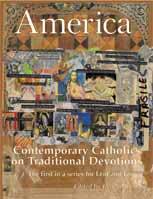Lectio divina is Latin for spiritual reading. It is a method of reading and praying on Scripture and other classics of spirituality like Augustine’s Confessions and TheImitation of Christ. It has deep roots in the history of monasticism. There are four basic steps in lectio divina: reading (What does this text say?), meditation (What does this text say to me?), prayer (What do I want to say to God through this text?) and contemplation or action (What difference might this text make in my life?).
The text to be read can be long or short. And the full process of reading could take 15 minutes or be spread over 15 years. To illustrate the process, I will focus on Jesus’ invitation in Mt 11:28: Come to me, all you who are weary and carrying heavy burdens, and I will give you rest.
Reading (lectio) the text involves basic literary analysis that is, looking at its context, words and images, characters, literary form and structure. Here Jesus issues an invitation to come to his wisdom school and promises both wisdom and rest to those who accept. The saying is part of a passage (Mt 11:25-30) that reveals Jesus as both the Son of God and incarnate Wisdom in a context (Chaps. 11-12) where the themes of unbelief and rejection are prominent. One’s appreciation of Jesus’ invitation and promise grows when the passage is read alongside Jer 6:16 (where the good way lies...walk in it, and find rest for your souls) and Sir 51:26-27 (put your neck under her [Wisdom’s] yoke.... I have labored little and found much serenity).
Meditation (meditatio) takes account of both the content of the passage and the present dispositions of the reader. Many rich theological themes emerge from Mt 11:28: real wisdom as divine revelation, the human search for wisdom and rest, Jesus as a gentle and humble teacher, Jesus as Wisdom incarnate and so on.
What this text says to me will also depend to some extent on my state of soul as I read it. I may be tired, discouraged and depressed, and so badly in need of rest. Or I may be feeling wonderful, hoping for a new breakthrough on the way of wisdom and more convinced than ever that true wisdom is to be found only in the teaching and example of Jesus.
Prayer (oratio) flows from reading and meditating on the text. This step, of course, is very personal. I may ask God for peace of soul. Or I may praise God for the gift of faith and the wisdom of Jesus. Or I may thank God for having revealed himself in and through Jesus to little ones.
The fourth step may take the form of contemplatio (relishing the spiritual experience and praising God for it) or actio (discerning some course of action). For example, through Mt 11:28 I may decide to devote myself to learning more about the wisdom of Jesus. Or I may determine to make a retreat or to pray more regularly. Or I may just take a vacation, or at least try to grasp what the rest that Jesus promises means for how I live and work.
Lectio divina is profoundly simple and eminently flexible. While rooted in monastic practice, it is also part of the larger heritage of Christian spirituality. It can help greatly in integrating biblical scholarship and the devotional life. It can be used with Ignatian contemplation (application of the senses and identification with the characters), especially in meditatio.
For individuals and groups just beginning the practice of lectio divina, it may be wise to follow the four-step outline rather mechanically. But I must confess that I now seldom consciously work through the various steps all in one time period. In fact, the point of lectio divina is to foster an immersion in Scripture so that the various questions arise naturally in their own time. For one who has been privileged to study, teach and write about Scripture for many years, the framework has become so habitual that eventually all the steps get covered in one way or another. A wise teacher once told me, When you have mastered a method or skill, then you can throw away the instruction booklet.
The fathers of the church originated lectio divina, with Jerome especially giving it structure. Benedict incorporated it into his monastic rule, and in the 12th century Guigo II (the ninth prior of the Grande Chartreuse) wrote an important letter on it entitled The Ladder of Monks.
While lectio divina never disappeared from the Christian tradition since patristic times, it has undergone a revival in large part through the recently retired archbishop of Milan, Cardinal Carlo Maria Martini, S.J. A distinguished biblical scholar and former rector of the Pontifical Biblical Institute in Rome, Martini used lectio divina as a pastoral tool in his archdiocese and in his many books. Through Martini’s imaginative leadership, lectio divina has become available to everyone, not only for private devotions but also for communal Bible studies, prayer groups and liturgical activities.
If we are committed to the mandates of the Second Vatican Council to make Scripture the soul of theology and to become a more biblical church, lectio divina can be an effective tool, tested by hundreds of years of experience. It is another case of bringing out of our biblical treasure what is new and what is old (Mt 13:52). While lectio divina is old, its use as a pastoral tool for the whole church is new and promising.








